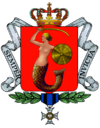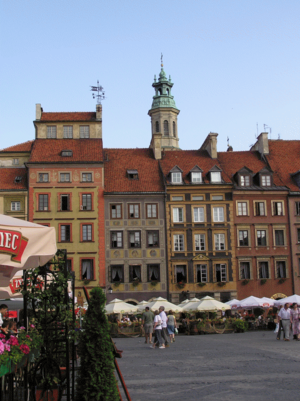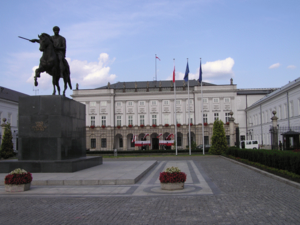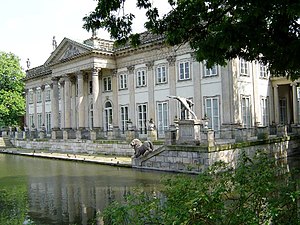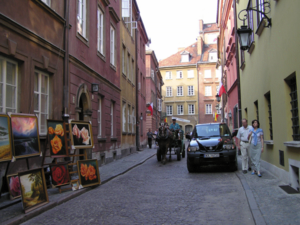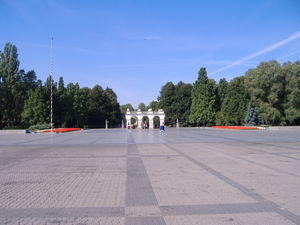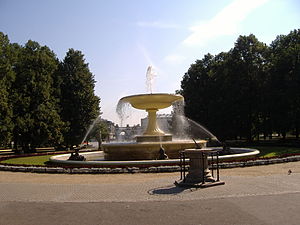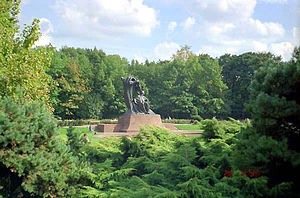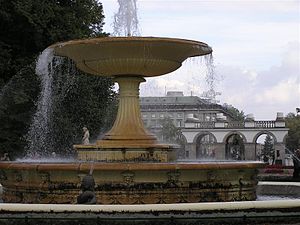Warsaw
From Wikipedia, the free encyclopedia.
- For other uses, see Warsaw (disambiguation) and Warszawa (disambiguation).
Warsaw (Polish Warszawa, ![]() [vɑrˈʃɑvɑ](?), in full The Capital City of Warsaw, Polish: Miasto Stołeczne Warszawa) is the capital of Poland and its largest city. It is located on the Vistula river roughly 350 km from both the Baltic Sea coast and the Carpathian Mountains. Its population as of 2004 was estimated at 1,676,600, with an urban agglomeration of approximately 2,400,000. The area of this city comprises 516.9 km², with an urban agglomeration of 1226.6 km².
[vɑrˈʃɑvɑ](?), in full The Capital City of Warsaw, Polish: Miasto Stołeczne Warszawa) is the capital of Poland and its largest city. It is located on the Vistula river roughly 350 km from both the Baltic Sea coast and the Carpathian Mountains. Its population as of 2004 was estimated at 1,676,600, with an urban agglomeration of approximately 2,400,000. The area of this city comprises 516.9 km², with an urban agglomeration of 1226.6 km².
The city, also the capital of Masovian Voivodship, is home to many industries (manufacturing, steel, electrical engineering, automotive); it features 66 institutions of higher learning, including Warsaw University, Warsaw University of Technology, the Higher School of Business and the Medical Academy. Warsaw is home to over 30 theatres, including the National Theatre and Opera and the National Philharmonic Orchestra.
| Warsaw | |||||
|
|||||
| Motto: Contemnit procellas (It defies the storms) Semper invicta (Always invincible) |
|||||
 |
|||||
|---|---|---|---|---|---|
| Voivodship | Masovian | ||||
| Municipal government | Rada miasta st. Warszawy | ||||
| Mayor | Lech Kaczyński | ||||
| Area | 516,9 km² | ||||
| Population - city - urban - density |
1,676,600 2,400,000 3258/km² |
||||
| Founded City rights |
13th century turn of the 13th century |
||||
| Latitude Longitude |
52°15' N 21°00' E |
||||
| Area code | +48 22 | ||||
| Car plates | WA to WZ | ||||
| Twin towns | Astana, Berlin, Düsseldorf, Hague, Hamamatsu, Hanoi, Kyiv, Moscow, Paris, Riga, Seoul, St. Petersburg, Taipei, Tel Aviv, Toronto, Vienna, Vilnius | ||||
| Municipal Website | |||||
Contents |
Location
Warsaw straddles the Vistula river, approximately 350 kilometres from both the Carpathian mountains and the Baltic Sea. It is located in the heartland of the Masovian Plain. Average altitude is 100 m above sea level, although there are some hills (mostly artificial) located within the confines of the city.
Climate
Warsaw's climate is continental humid. The average temperature is 8 degrees Celsius (-3 °C in January and 19 °C in July). Yearly rainfall averages 680 mm, the most rainy month being July.
History


The first fortified settlements on the site of today's Warsaw were Bródno (9th/10th century) and Jazdów (12th/13th century). After Jazdów was raided in 1281 by Boleslaus II, the Duke of Płock, a new similar settlement was lodged on the grounds of a small fishing village called Warszowa. In the beginning of the 14th century it became one of the seats of the Dukes of Masovia, in 1413 becoming the capital of Masovia. Upon the extinction of the local ducal line, the duchy was reincorporated into the Polish Crown in 1526. In 1529 Warsaw for the first time became the seat of the General Sejm, permanent since 1569. In 1572 Warsaw gave its name to the Warsaw Confederacy, an agreement by the Polish gentry to tolerate different religious faiths in the Kingdom of Poland.
Due to its central location between the Polish-Lithuanian Commonwealth's capitals of Vilna and Cracow, Warsaw became the capital of Poland in 1596, when King Sigismund III Vasa moved the capital from Cracow. Warsaw remained the capital of the Polish-Lithuanian Commonwealth until 1795, when it was annexed by the Kingdom of Prussia to become the capital of the province of New East Prussia. Liberated by Napoleon's army in 1807, Warsaw was made the capital of the newly created Duchy of Warsaw. Following the decisions of the Congress of Vienna of 1815, Warsaw became the center of the Polish Kingdom, a constitutional monarchy under a personal union with the Imperial Russia.
Following the repeated violations of the Polish constitution by the Russians, the 1830 November Uprising broke out. However, the Polish-Russian war of 1831 ended in the uprising's defeat and in the curtailment of the Kingdom's autonomy.
On 27 February 1861 a Warsaw crowd protesting the Russian rule over Poland was fired upon by the Russian troops. Five people were killed.
Warsaw become the capital of the newly independent Poland again in 1918.
Warsaw flourished in the late nineteenth century under Mayor Sokrates Starynkiewicz (1875–1892), a Russian-born general appointed by Tsar Alexander III. Under Starynkiewicz Warsaw saw its first water and sewer systems designed and built by the English engineer William Lindley and his son, William Heerlein Lindley, as well as the expansion and modernization of trams, street lighting and gas works.
In the course of the Polish-Bolshevik War of 1920, the huge Battle of Warsaw was fought on the Eastern outskirts of the city in which the capital of Poland was successfully defended and the Red Army defeated.
Warsaw is notable among Europe's capital cities not for its size, age, or beauty, but for its indestructibility. It is a phoenix that has risen repeatedly from the ashes. Having suffered dreadful damage during the Swedish and Prussian wars of 1655–1656, it was again assaulted in 1794, when the Russian army massacred the population of the right-bank suburb of Praga. Its most remarkable act of survival, though, was its rebirth following its almost complete destruction during the Second World War.
The Second World War began when Germany invaded western Poland on 1 September 1939. On 17 September eastern Poland was invaded by the USSR. Poland capitulated after 6 weeks of fighting. Western Poland was incorporated into the German Reich, eastern Poland into the USSR, while central Poland, including Warsaw, came under the rule of the General Government, a Nazi colonial administration. In the course of the September Campaign, Warsaw was severely bombed, and in the course of the Siege of Warsaw approximately 10 to 15% of its buildings were destroyed.
Warsaw became an occupied city under the control of the Nazi SS. All higher education institutions were immediately closed and Warsaw's entire Jewish population — several hundred thousand, some 30% of the city — herded into the Warsaw Ghetto. When the order came to liquidate the Ghetto as part of Hitler's "final solution", Jewish fighters launched the Warsaw Ghetto Uprising. Despite being heavily outgunned and outnumbered, the Ghetto held out for almost a month. When the fighting ended, the survivors were massacred.
During 1943 and 1944 the tide of the war turned, as the USSR, which had been at war with Germany since 1941, inflicted a number of severe defeats on the German army. By July 1944 the Soviets were deep into the Polish territory, pursuing the Germans toward Warsaw. Knowing that Stalin was hostile to the idea of an independent Poland, the Polish government-in-exile based in London gave orders to the underground Home Army (AK) to try to seize the control of Warsaw from the Nazis just before the Soviets arrive. Thus, on 1 August 1944, as the Soviet army was nearing the city very fast, the Home Army and the general population started the Warsaw Uprising.
Despite Stalin's hostility towards Poland, the Poles had expected that the Soviet troops would assist them against their common German enemy. However, after the Red Army captured the right-bank Warsaw, the Soviet offensive was stopped, while the Germans went on to ruthlessly suppress the uprising. Although the insurgency, planned to last 48 hours, held out for 63 days, eventually the Home Army fighters were forced to capitulate. They were transported to the POW camps in Germany, while the entire civilian population was expelled. Hitler, ignoring the negotiated terms of the capitulation, ordered the entire city to be razed to the ground, and the library and museum collections burned. When on 17 January 1945 the Soviets crossed Vistula and entered the left-bank Warsaw, 85% of the city had been destroyed, including the historic Old Town and the Royal Castle. The surviving Home Army fighters were rounded up by the NKVD and either killed or deported to Siberia.
After the war, Boleslaw Bierut's puppet regime set up by Stalin made Warsaw the capital of the communist People's Republic of Poland, and the city was resettled and rebuilt. A lot of plattenbaus (housing projects) can be found in Warsaw. Few of the inhabitants of the pre-war Poland returned: Hundreds of thousands were dead, thousands more in exile from the new regime. Nonetheless, the city resumed its role as the capital of Poland and the country's center of political and economic life. Many of the historic streets, buildings, and churches were restored to their original form. In 1980, the historic Old Town of Warsaw was inscribed onto UNESCO's World Heritage list.
In 1995 the Warsaw Metro finally opened, and with the entry of Poland into the European Union in 2004, Warsaw is currently experiencing the biggest economic boom of its history.
Famous people
Famous people born, living or working in Warsaw:
- Eugeniusz Bodo (1899–1943?), singer and actor
- Zbigniew Brzeziński (b. 1928), political scientist, advisor to the US president Jimmy Carter
- Frédéric Chopin, (1810–1849), the greatest Polish composer
- Maria Skłodowska-Curie, (1867–1934), pioneer researcher into radioactivity, two-time Nobel Prize winner
- Lucyna Ćwierczakiewiczowa (1829–1901), the first Polish cookbook author
- Witold Gombrowicz (1904–1969), novelist and drama writer
- Agnieszka Holland (b. 1948), internationally acclaimed film director
- Jacek Kaczmarski, (1957–2004), songwriter, poet and author
- Lech Kaczyński, (b. 1949), politician, Solidarity activist
- Ryszard Kapuściński (b. 1932), writer and journalist
- Krzysztof Kieślowski (1941–1996), internationally acclaimed film director
- Krzysztof Komeda, (1931–1969), free jazz pioneer, composer
- Ryszard Kukliński (1930–2004), a CIA spy during the Cold War
- Kazimierz Kuratowski (1896–1980), mathematician
- Janusz Kusociński (1907–1940), athlete, champion at the 1932 Summer Olympics
- Tamara de Lempicka (1898–1980), painter
- Witold Lutosławski, (1913–1994), composer
- Benoît Mandelbrot (b. 1924), mathematician and creator of Mandelbrot set
- Władysław Reymont (1867–1925), writer and novelist, Nobel Prize winner
- Wacław Sierpiński (1882–1969), mathematician
- Stefan Starzyński (1893–1943?), heroic mayor of Warsaw 1934–1939, murdered by the Nazis
- Stanisław Staszic (1755–1826) clergyman, writer, publicist, translator, philosopher and Enlightenment activist;
- Władysław Szpilman, (1911–2000), composer and author of The Pianist
- Stanisław Ignacy Witkiewicz aka Witkacy (1885–1939), writer and painter
- Janusz A. Zajdel (1938–1995), science-fiction writer
Population
Historical population

- 1700: 30,000 (estimated)
- 1792: 120,000
- 1800: 63,400
- 1830: 139,700
- 1850: 163,600
- 1882: 383,000
- 1900: 686,000
- 1925: 1,003,000
- 1939: 1,300,000
- 1945: 422,000 (in September)
- 1956: 1,000,000
- 1960: 1,139,200
- 1970: 1,315,600
- 1975: 1,436,100
- 1980: 1,596,100
- 1990: 1,611,800
- 2002: 1,707,100 (after incorporating Wesoła)
- 2004: 1,676,600 (urban agglomeration 2,400,000)
Municipal government
Administrative division

Warsaw is a municipal powiat (county) and is further divided into 18 districts, each one known as a dzielnica (map), each one with its own administrative body. Each of the districts is divided into neighborhoods which are not officially recognized by the city but known by most Varsovians. The best known neighborhoods are Stare Miasto and Nowe Miasto in the district of Śródmieście.
Warsaw districts (since 2002):
- Bemowo
- Białołęka
- Bielany
- Mokotów
- Ochota
- Praga Północ
- Praga Południe
- Rembertów
- Śródmieście
- Targówek
- Ursus
- Ursynów
- Wawer
- Wesoła (since 2002; a separate city before then)
- Wilanów
- Włochy
- Wola
- Żoliborz
Notable suburbs include (number of inhabitants given in brackets):
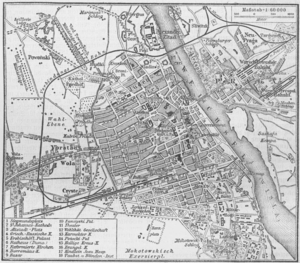
- Grodzisk Mazowiecki (24,900)
- Legionowo (50,600)
- Marki (19,000)
- Nowy Dwór Mazowiecki (27,200)
- Otwock (44,000)
- Piaseczno (25,200)
- Piastów (23,700)
- Pruszków (53,000)
- Wołomin (36,500)
- Żyrardów (31,900)
The mayor (the President of Warsaw)
-
- See also: President of Warsaw
Following the Warsaw Act (Ustawa warszawska) of October 27, 2002, the President of Warsaw carries out the executive duties in the city. His prerogative is, among others, governing the city-owned property that constitutes a major part of the city. The current President of Warsaw is Lech Kaczyński. He will soon have to step down, however, because he became the president of the Republic of Poland after the elections that were held in October of 2005.
Municipal government
The Warsaw Act abolished all the former counties around Warsaw and formed one city powiat with a unified municipal government.
Legislative power in Warsaw is vested in a unicameral City Council (Rada Miasta), which comprises 60 members. Council members are elected directly every four years. Like most legislative bodies, the City Council divides itself into committees which have the oversight of various functions of the city government. Bills passed by a simple majority are sent to the mayor (the President of Warsaw), who may sign them into law. If the mayor vetoes a bill, the Council has 30 days to override the veto by a two-thirds majority vote.
Each of the 18 separate city districts has its own council (Rada dzielnicy). Their duties are focused on aiding the President and the City Council, as well as supervising various municipal companies, city-owned property and schools. The head of each of the District Councils is named the Mayor (Burmistrz) and is elected by the local council from the candidates proposed by the President of Warsaw.
Politics

-
- Main article: Members of Sejm from Warsaw constituency
As the capital of Poland, Warsaw is the political center of the country. All state agencies are located there, including the Polish Parliament, the Presidential Office and the Supreme Court. In the Polish parliament both the city and the area are represented by 31 MPs (out of 460). Additionally, two politicians were recently elected MEPs.
Transport
Although Warsaw was heavily damaged during World War II and reconstruction in the fifties widened many streets, the city is currently plagued with traffic problems. Public transportation in Warsaw is as efficient as it is ubiquitous, serving the city with buses, tramways, and a recently opened metro.
Roads and highways
Warsaw lacks a good circular road system and most of the East-West traffic goes directly through the city center. Currently two circular roads are under construction. The first (called OEW, or Obwodnica Etapowa Warszawy) is to lead the traffic approximately 10 kilometres from the city center through the city streets and two newly-built bridges ([1]). The other is to become a part of both the A-2 (Berlin-Moscow) and the A-7 (Gdańsk–Kraków) motorways and run through a tunnel under the southern area of Ursynów. It is to become available between 2008 and 2010.
Airports
Warsaw has one international Airport, Warsaw Frederic Chopin Airport, located just 10 km away from the city center. With over 60 international and domestic flights a day and with over 5 million passengers a year it is by far the biggest airport in Poland. Immediately adjacent to the main Frederic Chopin Airport terminal complex is the Etiuda terminal which serves both domestic routes and the international routes flown by low-cost carriers.
There are also plans for a second international airport to be built, mostly for service to other European Union countries. It is to be located either just outside of the city limits at the site of one of the former military airports or in one of the suburbs to the North or to the West.
Mass transit
The public transportation system in Warsaw consists of three branches (buses, streetcarss and metro) united in the ZTM (Zarząd Transportu Miejskiego or the City Transportation Office). Additional lines are operated by private companies and the state-owned railways.
Buses
Bus service covers the entire city, with 176 routes totalling 2,603 kilometres in length, and with 1,659 vehicles in service. The central bus stop is located next to Warszawa Centralna railway station and the Centrum Metro station. Between midnight and 5 am the city is served by 14 night lines. The first digit of the line's number indicates its type:
- 1** - normal line (operates all day, seven days a week, stops at every bus stop on the route)
- 2** - special line (only on special occasions, e.g. the cemetery lines on November 1, or as a replacement for a metro or streetcar line that is temporarily out of order)
- 3** - period line - normal (operates only at selected hours and on certain days, usually during peak hours, stops at every stop on the route)
- 4** - period line - fast (operates only at selected hours and on certain days, usually during peak hours, stops only at selected stops)
- 5** - fast line (operates all day, seven days a week, stops only at selected stops)
- 6** - night line (operates at night only, all stops are on-demand)
- 7** - suburb line (operates all day, seven days a week, goes outside the borders of Warsaw)
- 8** - suburb period line (operates only at selected hours and on certain days, usually during peak hours, goes outside the borders of Warsaw)
- E-* - express line (stops only at major stops)
Streetcars
The first streetcar line in Warsaw was opened on 11 December 1866. On 26 March 1908, all the lines, previously horse-powered, were electrified. In the interbellum the tramway was nationalized and the net was extended significantly. After the Defence War of 1939 the service was halted for approximately three months due to war losses. Heavy aerial bombardment during the siege of Warsaw and requisition of all modern cars by the new German authorities postponed the reintroduction of service. However, by 1940 the trams were back on track. In 1941 the present colors of the cars were introduced (yellow and red, in accordance with the Flag of Warsaw colors. This was done to demoralize the Poles in the city by attempting to wipe out all traces of the white and red colors of Poland. Up until this point, the trams were painted either in a white and red mixture, or entirely red).
Following the Warsaw Uprising the tram net was consistently destroyed by the Germans until the liberation of the ruins in January 1945. The streets were filled with rubble, the tram stations destroyed and the cars either burnt or transported to Germany. However, the first streetcar line was opened again for the public on 20 June 1945.
Following the Second World War the tram net in Warsaw was in fast development. The track net reached all the principal parts of the city. However, in the sixties the official policy of both Polish and Soviet authorities promoted usage of Soviet oil and exportation of Polish coal. The availability of coal on the home market was decreased and the tramway net was shortened while more buses were bought. Until 1989 only 28 lines were preserved.
Currently the Tramwaje Warszawskie company runs 863 cars on almost 470 kilometres of track. Twenty-nine lines run across the city with additional lines opened on special occasions (such as public holidays or All-Saints Day).
Trolleybuses

After the World War II most of the communication network in Warsaw was destroyed. The streets were filled with rubble, and the streetcar infrastructure was either transported to Germany by the Wehrmacht or destroyed.
However, the city entered the path of quick reconstruction and was in need of a transport network both cheap and efficient. In 1946 several dozens of trolleybuses were brought in from the Soviet Union and first two lines were soon opened. The trolleybuses were using ex-tramway lines and the lines ran from Union of Lublin square (Plac Unii Lubelskiej) to Warszawa Gdańska train station, and from Łazienkowska depot to the city center (Piękna street area).
In March 1946 a second line was opened (Plac Saski–Bonifraterska), but was closed and replaced by streetcars in December. However, the reconstruction of the tramway was halted, mostly for political reasons, and until 1955 5 new trolleybus lines were opened, covering most of the city center.
See: trolleybus network map of this period
1967 started a period of fast decline in both the number of trolleybuses and the trolleybus lines in Warsaw. PZPR policies under Edward Gierek assumed that as much Polish coal as possible be exported while the oil be imported at very low prices from the USSR. It was decided that production of electricity should be lowered in order to spare resources and by 7 July 1973 all trolleybus lines in Warsaw were closed.
The last period of Warsaw trolleybus transportation started in 1977, when it was decided that the existing cars could be used as a means of mass transit between Warsaw and the southern suburb of Piaseczno. An additional line was planned through Wilanów (now a part of the city), Powsin and Konstancin-Jeziorna. However, the contemporary economic crisis made construction of the latter line impossible, and only the Piaseczno line was opened on 1 July 1983.
After the system transformation of 1989 it became apparent that the trolleybuses were in dire need of replacement (those used were built in early 1950s), and that the maintenance costs of running a single line were very high. On 1 September 1995 the Warsaw City Council decided that all services on the 51 and 651 lines be halted. In July 2000 the trolleybus depot in Piaseczno was closed and the remaining cars sold to Minsk, Lublin (where most of them languish in a field behind the main area of a trolleybus depot awaiting refurbishment and return to service; a lack of funds prevents this from going ahead) and to various museums.
See: trolleybus line map of this period
Metro
For detailed info on the Warsaw underground railway see: Warsaw Metro.
Railway
The first railroad reached Warsaw in 1848 (the Warsaw-Vienna line). Nowadays Warsaw is one of the main railway nodes and exchange points in Poland. Cheap and fairly efficient, the PKP (Polskie Koleje Państwowe, or Polish State-owned Railways) are one of the principal means of transport in Poland.
The main train station is Warszawa Centralna. Both the domestic and the international connections run from there to almost every major city in Poland and Europe. There are also 5 additional major train stations and a number of smaller stations for suburban lines.
The railway crosses under the city through a tunnel (tunel średnicowy). It is approximately 2.2 km long and runs directly under the city center. It is a part of an east-west line connecting the Warszawa Zachodnia, Warszawa Centralna and Warszawa Wschodnia train stations through the tunnel and a railway bridge over the Vistula river. There are plans for converting this line into metro.
The principal train stations are:
- Warszawa Centralna
- Warszawa Gdańska
- Warszawa Wileńska
- Warszawa Zachodnia
- Warszawa Wschodnia
Sports
-
- Main article: Sports in Warsaw
- Polonia Warszawa - men's football team (est. 1911), (Polish Champion: 1948, 2000; Polish Cup winner: 1952, 2001; Polish SuperCup winner: 2000; 1st league in 2005/2006 season)
- Legia Warszawa - men's football team (est. 1916), (Polish Champion: 1955, 1956, 1969, 1970, 1994, 1995, 2002; Polish Cup winner: 1955, 1956, 1964, 1966, 1973, 1980, 1981, 1989, 1990, 1995, 1995, 1997; Polish SuperCup winner: 1989, 1994, 1997; 1st league in 2005/2006 season)
Culture
Theatre

Warsaw is home to over 30 major theatres that are spread throughout the city, including the National Theatre (founded in 1765) and the Grand Theatre in Warsaw ([2]) (established 1778).
Warsaw also attracts many young and off-stream directors and performers who add to the city's theatre culture. Their productions can be seen mostly in the smaller theatres and Houses of Culture (Dom Kultury) located mostly outside of the Śródmieście. Presently, one of the most successful is the TR Warszawa (formerly Teatr Rozmaitości), one of the most notable scenes in Poland.
Museums and art galleries
There are many museums and art galleries in Warsaw, most notable are the Muzeum Narodowe, Zachęta Art Museum, Center for Contemporary Art, Museum of the Polish Army. The biggest of them, the National Museum has numerous divisions located in many parts of Warsaw, most notably in the Royal Castle and the Wilanów Palace.
Since 2004 the Warsaw Uprising Museum [3] is open to the public.
Film
-
- Main article: movies featuring Warsaw
Since World War II Warsaw has been the second most important center of film production in Poland. As the capital of Poland it has also been featured in countless movies, both Polish and foreign. Movies such as Kanał and Korczak by Andrzej Wajda, Eroica by Andrzej Munk, Miś by Stanisław Bareja or The Pianist by Roman Polański used Warsaw either as the background, or as the main protagonist.
Education
-
- For a full list of Warsaw-based institutions of higher education see: Education in Warsaw
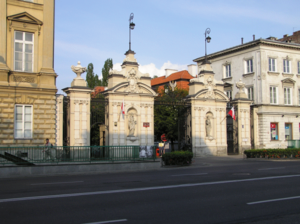
Warsaw is one of the most important education centers of Poland. It is home to four major universities and over 62 smaller schools of higher education. The most important are:
- University of Warsaw (Uniwersytet Warszawski)
- Warsaw University of Technology (Politechnika Warszawska)
- Warsaw School of Economics (Szkoła Główna Handlowa)
- Warsaw Agricultural University (Szkoła Główna Gospodarstwa Wiejskiego)
- Cardinal Stefan Wyszyński University (Uniwersytet Kardynała Stefana Wyszyńskiego)
- Medical University of Warsaw (Akademia Medyczna w Warszawie)
- Academy of National Defence (Akademia Obrony Narodowej)
- Academy of Physical Education in Warsaw (Akademia Wychowania Fizycznego w Warszawie)
- Fryderyk Chopin Academy of Music (Akademia Muzyczna im. Fryderyka Chopina)
- Theatre Academy (Akademia Teatralna im. Aleksandra Zelwerowicza)
See also: List of universities in Poland
The overall number of students of all grades of education in Warsaw is almost 500,000 (29.2% of the city population; 2002). The number of university students is over 255,000.
Economy
Business and commerce
Warsaw, and especially its downtown area of Śródmieście is not only home to many national institutions and government agencies, but also plays host to a huge number of both domestic and international companies. In 2003 268,307 companies were registered in the city. Warsaw is seen as the heart of Poland by foreign investors whose financial participation in the city's development was estimated to be over 650 million euro a year (2002). Warsaw produces more than 15 % of Poland's income.
At the same time the unemployment rate is one of the lowest in Poland, not exceeding 6.5%, according to the official figures.
The city itself collects 5,162,324 złotys in taxes and direct government grants.
It has been said that Warsaw, together with Frankfurt, London and Paris, is one of the tallest cities in Europe. 11 tallest skyscrapers of Poland, 9 of which are office buildings, are located in Warsaw. The centrally located tallest structure, the Palace of Culture and Science, is the 4th tallest building in the European Union.
Stock Exchange
Although Warsaw was home to a stock exchange since 1817, in 1945, because of political changes after World War II, it couldn't be recreated. It only started operating again in April 1991, after the reintroduction of the free-market economy and democracy. It is now the biggest stock exchange in Central and Eastern Europe, with more than 130 companies listed. The main indexes of its performance are WIG and WIG20.
History likes funny twists — it's worth mentioning that from 1991 until 2000 the Warsaw Stock Exchange was situated in the building previously used as the headquarters of the Polish Communist Party (PZPR).
Industry
Following the destruction of the city in World War II and its reconstruction, the communist authorities decided that Warsaw be rebuilt as a major industrial center. Several hundred major factories were build in the city or just outside of it. Most notable were the Huta Warszawa Steel Works and two car factories.
However, as the communist economical system deteriorated, most of them lost any significance. In the years following 1989, in the course of a peaceful transformation of both political and economical system in Poland, most of these went bankrupt. Nowadays, the Lucchini-Warszawa Steel Mill (formerly Huta Warszawa) is the only major factory remaining.
Tourist attractions
- Main article: Tourist attractions in Warsaw
Although Warsaw is a reasonably new city, it has a lot of tourist attractions. Apart from the Old Town quarter, carefully reconstructed after World War II, each of the borrough has something to offer. Among the most notable landmarks of the Old Town are the Royal Castle, Sigismundus' Column and the Barbican.
Further south is the so-called Royal Road, with lots of notable classicist palaces, the Presidential Palace and the Warsaw University campus. Also the popular Nowy Świat Street is worth mentioning.
The oldest Warsaw's public park, the Ogród Saski, is located within 10 minutes distance of the old town. Another such oasis of silence and serenity is the Powązki Cemetery, one of the oldest cemeteries in Europe, filled with hundreds of precious sculptured, some of them by the most renown artists of 19th and 20th centuries. Since it serves the religious communities of Warsaw, be it Catholics, Jews, Muslims or Protestants, it is often called a necropolis. Nearby is the Okopowa Street Jewish Cemetery, one of the largest Jewish cemeteries in Europe.
To the north of the city center the museum of the former Warsaw Ghetto is located, which is also a popular locality often visited by foreign tourists. Also the borough of Żoliborz is famous for its architecture from the 1920s and 1930s. Between Żoliborz and the Vistula the Warsaw Citadel is located, which is one of the priceless monuments of 19th century military architecture in Poland. Also the former royal residencec of king Jan III Sobieski in Wilanów and Belweder are notable for their baroque architecture and beautiful parks.
However, Warsaw is perhaps the most famous for several buildings from modern history. Apart from the Palace of Culture and Science, a Soc-realist skyscrapper located exactly in the city center, the Stadion Dziesięciolecia which is the biggest market in Europe also attracts many tourists. For those who seek dramatic contrasts the borough of Central Praga is often the best choice. Called by the Varsovians the Bermuda Triangle for high crime rate, it is a place where almost completely demolished houses stand right next to modern apartment buildings and shopping malls.
See also
- Battle of Warsaw
- Warsaw dialect
- Stefan Starzyński
- Warsaw concentration camp
- Warsaw Pact
- Warsaw Fire Brigade
- Warsaw Metro
- History of Poland
- Royal coronations in St. John's Cathedral
- Soviet military cemetery in Warsaw
- Dukes of Masovia
- List of films featuring Warsaw
- Members of Polish Parliament elected from Warsaw constituency
External links
- Official web page of Warsaw
- Official tourist web page of Warsaw
- Travel guide to Warsaw from Wikitravel
- Interactive city map
- Panorama of the city center
- Skyline of Warsaw
- Skyscrapers Diagram of Warsaw
- Modern architecture in Warsaw
- Socrealistic architecture in Warsaw
- Warsaw Uprising 1944
- Royal Castle
- Wilanów Palace
|
|
|
|---|---|
| Voivodships of Poland Greater Poland | Kuyavia-Pomerania | Lesser Poland | Lower Silesia | Lublin | Lubusz | Łódź | Masovia | Opole | Podlachia | Pomerania | Silesia | Subcarpathia | Świętokrzyskie | Warmia and Masuria | West Pomerania |
|
| Principal cities Warsaw | Łódź | Kraków | Wrocław | Poznań | Gdańsk | Szczecin | Bydgoszcz | Lublin | Katowice | Białystok | Częstochowa | Gdynia | Gorzów Wlkp. | Toruń | Radom | Kielce | Rzeszów | Olsztyn |
|


